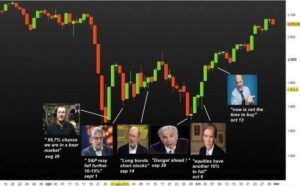In the ever-evolving world of finance, investing in stock markets remains a cornerstone for building personal wealth and achieving financial independence. This article, ‘Maximizing Profits: Navigating the World of Stocks,’ aims to equip investors with the knowledge and strategies necessary to thrive in the stock market. Whether you’re a novice or an experienced investor, the insights provided here will help you maximize returns, manage risks, and make informed decisions to grow your wealth over time.
Key Takeaways
- Identifying stocks with strong potential and employing sell discipline guided by technical analysis can significantly enhance investment returns.
- Investors should learn to sell into strength to secure profits and avoid the pitfalls of market volatility and giving back unrealized gains.
- Diversifying your portfolio can help manage risk, but concentrated positions in high-performing stocks can also lead to substantial wealth growth.
- A long-term investment approach with a focus on patience and a marathon mindset can yield substantial rewards, even in fluctuating markets.
- Utilizing stop-losses and taking partial profits are crucial tactics for protecting gains and preventing losses in uncertain market conditions.
Riding the Bull: Smart Moves in a Soaring Market

Spotting the High-Flyers: Picking Stocks with Potential
In the adrenaline-fueled arena of stock trading, spotting the high-flyers is like finding a needle in a haystack. But oh boy, when you do, it’s like striking gold. So, how do you sift through the chaff to find those potential unicorns?
First, you gotta keep your eyes peeled for stocks that are flexing their muscles with a 52-week high in Relative Strength. It’s like they’re waving a blue flag saying, ‘Hey, look at me!’ But it’s not just about the show of strength; you want to see them chilling in a base, ready to sprint.
Remember, it’s not just about picking winners from the last rodeo. Last cycle’s champs might not have the stamina for another round. It’s about finding the new leaders that can take the market by storm.
Here’s a simple 3-step process to get you started:
- Increase your exposure gradually, don’t go all in at once.
- Look for signs of leadership in stocks that are just starting to trend.
- Use tools like MarketSmith to analyze the positions and trading activity of top portfolio managers.
By following these steps, you’re not just throwing darts in the dark. You’re making informed decisions based on what the big players are betting on. And let’s be real, who wouldn’t want a piece of that action?
Sell High, Smile Wide: Knowing When to Cash Out
Cashing out at the right moment is the sweet spot of stock trading. Knowing when to let go of a stock is as crucial as picking the right one. You want to ride the wave of success, but not get wiped out when it crashes. Here’s a simple truth: stocks don’t go up forever. So, when your stock hits that 20% to 25% profit from a breakout point, it might be time to start thinking about taking gains.
It’s not just about the highs; it’s about securing those highs. Selling into strength is a strategy that can prevent you from giving back your unrealized profits. Use moving average lines as a guide, and don’t shy away from taking partial profits. Remember, it’s not a profit until you sell.
And let’s talk about stop-losses. They’re your safety net, your profit protection. Set them wisely and adjust them upwards as your stock climbs. This way, you lock in gains and avoid the heartache of watching a winning stock plummet. Here’s a quick checklist to keep in mind:
- Sell into strength on the way up
- Use moving average lines as a sell signal
- Take partial profits to secure gains
- Implement a stop-loss rule and adjust it as needed
By following these steps, you can smile all the way to the bank, knowing you’ve maximized your profits without leaving too much on the table.
Diversify or Dive Deep: Balancing Your Portfolio
When it comes to investing, there’s a fine line between spreading your bets and putting your chips on the sure winners. Diversification is key to managing risk, but there’s also something to be said for the concentrated positions that can lead to outsized gains. It’s like a buffet; you want a bit of everything, but you also know which dishes are your favorites.
- CREATE A DIVERSIFIED PORTFOLIO: Start by spreading your investments across various sectors, industries, and geographic locations. This can protect your portfolio from volatility and ensure more stable returns over time.
- KEEP COSTS LOW: Remember, every penny saved is a penny earned. Look for low-cost investment options to maximize your returns.
How can you hold concentrated positions but still use diversification to reduce risk? It’s about balance. Diversify by asset class and time frame, not just by the number of stocks.
While conventional wisdom pushes for wide diversification, some of the world’s best investors have thrived with concentrated portfolios. The trick is to rebalance periodically to prevent any single investment from skewing your portfolio too much. Whether you’re a bull or a bear, a diversified approach can give you the peace of mind that you’re building a solid foundation for growth, regardless of market swings.
Shark Tactics: Trading Strategies for the Hungry Investor

The Buy Low Myth: Timing the Market vs. Time in the Market
We’ve all heard the old adage: buy low, sell high. But let’s get real, timing the market is like trying to catch a falling knife. It’s risky, and more often than not, you end up with a few cuts. Time in the market beats timing the market. It’s about playing the long game, letting compound interest work its magic over the years.
It’s tempting to wait for the ‘perfect moment’ to invest, but here’s the kicker: the perfect moment is a myth. The market’s a wild beast, unpredictable in the short term. So, what’s an investor to do?
- Embrace dollar-cost averaging: Regular investments over time can smooth out the highs and lows.
- Stay informed: Keep an eye on your investments, but don’t obsess over daily fluctuations.
- Patience is key: Remember, some markets take years to reach new highs, but historically, they trend upwards.
Remember, folks, it’s not about snagging the biggest gains in the shortest time. It’s about consistent growth, riding out the storms, and not getting spooked by market volatility. After all, it’s the steady climb that builds the mountain.
Charting Success: Technical Analysis for the Win
Ever felt like you’re trying to decipher an ancient script when looking at stock charts? Fear not! Technical analysis is your Rosetta Stone in the world of stocks. It’s all about spotting those patterns that scream ‘Buy me!’ or ‘Sell me!’ like a neon sign on the Vegas strip.
For instance, when a stock breaks out of a well-formed base, that’s your cue to swoop in. But if you spot a chart pattern that looks like it’s been drawn by a toddler with a crayon, maybe step away. It’s not just about the patterns, though. You’ve got to keep an eye on those sneaky distribution days that can signal a shift in momentum.
- Identify the Pattern: Look for classic chart patterns that indicate a potential breakout.
- Check the Volume: A breakout with high volume is more likely to succeed.
- Watch the Indicators: Use tools like the relative strength line to confirm your moves.
Remember, the goal isn’t to predict the future with 100% accuracy; it’s about increasing the odds in your favor. And with a bit of practice, you’ll be reading charts like a pro, making informed decisions that could lead to hefty profits.
The Art of the Exit: Securing Profits Before the Tide Turns
Mastering the exit strategy is like knowing the perfect time to leave a party; too early, and you miss the fun, too late, and you’re stuck in the cleanup. Knowing when to sell into strength is crucial to lock in those gains before they slip away. It’s not just about the highs; it’s about securing profits while you’re up.
- When to sell into strength on the way up
- Using moving average lines as a sell signal
- The art of taking partial profits
Remember, it’s not about timing the market to perfection, but about having a plan that captures profits and minimizes losses. Rising stop-losses can be your best friend, automatically locking in gains as the stock climbs. And don’t forget the golden rule: never let a winner turn into a loser. When you’re sitting on a stock that’s soared, consider taking some off the table. It’s like ensuring your bet when the odds are in your favor.
The key is to be proactive, not reactive. Set your stop-losses and stick to them. This way, you’re not making emotional decisions in the heat of the moment. And if you’re lucky enough to have a stock that’s up 100%, 200%, or more, handle it with care. These big winners can make your year, so don’t sell yourself short by cashing out too soon.
The Long Game: Investing for the Future Without Fear

The Marathon Mindset: Building Wealth Over Time
Let’s talk about the long haul, folks. Building wealth over time is like planting a tree; you gotta give it time to grow before you can enjoy the shade. It’s all about that marathon mindset, where slow and steady wins the race. You’re not looking for the quick buck; you’re in it to build a fortress of financial security that’ll stand the test of time.
- Educate yourself: Knowledge is power, and the market’s no exception.
- Set clear goals: Know what you’re aiming for and plan how to get there.
- Stay patient: Rome wasn’t built in a day, and neither is a robust portfolio.
It’s not just about having the stamina to keep going; it’s about the smarts to stick to a plan that works for you. Ditch the sprinter’s spikes for a pair of marathon running shoes.
Remember, investing is a journey, not a sprint. Keep your eyes on the prize, and don’t let the daily ups and downs throw you off your game. Stay disciplined, stay focused, and let time work its magic on your investments.
Risk and Reward: How to Play It Safe and Still Win Big
In the high-stakes game of stock investing, balancing risk and reward is the name of the game. It’s about making smart choices that can lead to big wins without putting your financial future in jeopardy. One key strategy is to set stop-loss orders, which act as a safety net to prevent significant losses. Think of it as a ‘break glass in case of emergency’ button for your investments.
Effective risk management isn’t just about avoiding losses; it’s also about knowing when to take profits. Here’s a simple list to keep in mind:
- Set clear goals for each investment
- Regularly review and adjust your portfolio
- Take partial profits to secure gains
- Use stop-losses to limit potential losses
Remember, the goal isn’t to eliminate risk—it’s to manage it in a way that aligns with your financial goals and risk tolerance. By continuously assessing and managing risk, you can navigate the market’s ups and downs with confidence.
The Power of Patience: When to Hold On for Dear Life
Let’s face it, the stock market is no sprint; it’s a marathon with hurdles, water stations, and the occasional cramp. Patience isn’t just a virtue; it’s your best bud when it comes to investing. It’s about playing the long game, where time in the market beats timing the market every time.
Investment Timing and Patience
While timing the market perfectly is nearly impossible, understanding market cycles and having patience can significantly enhance investment outcomes. Long-term investing has historically proven to be more rewarding, allowing investors to ride out market volatility and benefit from the compounding of returns. Setting clear investment goals and maintaining a long-term perspective can help in resisting the urge to make impulsive decisions based on short-term market movements.
Remember, it’s not about having a crystal ball to predict the market’s next move. It’s about sticking to your guns, even when the market’s playing yo-yo with your emotions.
Here’s a quick checklist to keep your patience in check:
- STAY DISCIPLINED: Investing is a long-term endeavor, and success often hinges on your ability to stay disciplined during periods of market volatility.
- MONITOR AND REBALANCE: Keep an eye on your investments and rebalance when necessary to ensure alignment with your long-term goals.
- TAKE ADVANTAGE OF DOLLAR-COST AVERAGING: This strategy can help mitigate the risks of market timing and allows you to build your position over time, regardless of market fluctuations.
Profit Protection: How to Keep Your Gains in Choppy Waters

Stop the Drop: Using Stop-Losses to Your Advantage
Ever watched your hard-earned gains vanish in a market nosedive? Ouch. That’s where a nifty little trick called a stop-loss order can be your best bud. It’s like a safety net for your portfolio, automatically selling off your stock if it hits a certain price, preventing a minor slip from turning into a freefall.
Here’s the deal: setting a stop-loss isn’t just about slapping on a random number. It’s an art. You’ve got to balance between cutting losses and giving your stock some wiggle room. Too tight, and you’ll get booted off the ride on every little dip. Too loose, and well, you might as well not have one.
Remember, the goal is to stop the drop, not to stop every little fluctuation. Think of it as setting the right level of ‘bumpiness’ you’re willing to endure on your investment journey.
So, how do you nail this balancing act? Here’s a quick rundown:
- Determine your risk tolerance: How much of a drop can you stomach before you bail?
- Analyze the stock’s volatility: More volatile stocks need more room to breathe.
- Set a percentage or dollar amount: Common wisdom suggests around 8% below your purchase price.
- Reassess regularly: As your stock grows, adjust your stop-loss to lock in profits.
By using stop-losses strategically, you’re not just protecting your portfolio; you’re giving yourself peace of mind. And that, my friend, is priceless.
Partial Profits: Taking a Slice While the Pie’s Hot
Ever been in that sweet spot where your stock’s just soaring and you’re grinning ear to ear? That’s your cue to consider skimming a bit off the top. It’s like taking a slice of pie before it cools down; you lock in some gains while the rest keeps baking.
Here’s the deal: You don’t have to sell all at once. Peeling off a portion of your position after a nice run-up can be a smart move. It’s about balance—securing profits and still staying in the game for potential future gains. Think of it as a ‘thank you’ to yourself for a job well done, while leaving a ‘let’s see what else you got’ portion in the market.
- Set a target: Decide in advance what gain percentage would trigger you to take some profits.
- Scale out: Instead of selling all at once, sell in increments. This can help you capture various profit levels as the stock climbs.
- Stay flexible: Market conditions change, so be ready to adjust your targets.
Remember, the goal isn’t to sell at the absolute peak—because who really knows where that is? It’s about making sure you don’t ride the wave only to wipe out when it crashes. By taking partial profits, you’re ensuring that no matter what, you walk away with something to show for your investment.
The Big Winners: Letting Your Stars Shine Without Burning Out
Ever hit the jackpot with a stock that just kept soaring? Holding on to your big winners can be as thrilling as a rollercoaster ride, but without the safety harness of a smart strategy, you might just end up walking away with cotton candy instead of cash. Here’s the deal: it’s not just about picking the right stock; it’s about knowing how to let it ride.
When you’ve latched onto a high-flyer, it’s tempting to cash out at the first sign of a dip. But savvy investors know that real wealth is built by resisting that knee-jerk reaction. Instead, they focus on maximizing gains and managing risks with tools like trailing stop-losses and partial profits.
Remember, the goal isn’t to win every single day. It’s about making those few, big plays count. George Soros himself pointed out that the secret to success was to focus on maximizing gains with the right stock and keeping losses small elsewhere. So, how do you keep from giving back your unrealized profits? Here are a few pointers:
- Sell into strength: Lock in profits by selling a portion of your position on the way up.
- Use moving averages: They can act as a sell signal, telling you when the momentum might be waning.
- Position sizing: It’s an underappreciated skill. More shares in a winner can mean the difference between a good year and a great one.
And don’t forget, it’s not about having a portfolio full of small wins; it’s about having those one or two big winners that can make your year. So, let your stars shine, but make sure they don’t burn out.
Wrapping It Up: Smart Moves in the Stock Game
Alright, folks, we’ve surfed through the gnarly waves of the stock market together, and it’s been quite the ride! Remember, the key to maximizing those profits is a blend of savvy investing strategies, a sprinkle of patience, and a dash of guts. Whether you’re playing the long game or looking for quick wins, keep your eyes peeled for those technical signals and don’t be shy to take profits when the getting’s good. And hey, don’t forget to set those stop-losses; they’re like your financial seatbelt. Investing is part art, part science, and all about staying on your toes. So go on, apply what you’ve learned, and may your portfolio grow fatter than a Thanksgiving turkey! Until next time, keep your investments smart and your spirits high!
Frequently Asked Questions
How can I identify stocks with the highest potential for growth?
Look for companies with strong fundamentals, innovative business models, and market leadership. Use technical analysis and research tools like MarketSmith’s 3-step approach to spot high-flyers.
When is the best time to sell a stock to maximize profits?
The best time to sell is when the stock shows technical signs of peaking, such as breaking below moving average lines. It’s also wise to sell into strength and set stop-losses to protect gains.
Should I diversify my portfolio or focus on a few stocks?
Diversification can reduce risk, but concentrated positions in high-potential stocks can lead to significant wealth. Balance is key; diversify across sectors but consider a few focused bets.
Is it better to time the market or have a long-term investment strategy?
While timing the market can be challenging, a long-term investment strategy allows you to benefit from market growth over time and reduces the impact of short-term volatility.
How can I protect my stock market profits in a volatile market?
Use stop-loss orders to prevent large losses, take partial profits when stocks are high, and keep an eye on technical indicators to gauge when to exit positions.
What is the significance of a long-term outlook in stock market investing?
A long-term outlook helps investors ride out market fluctuations and benefit from the compounding growth of stocks, leading to substantial wealth accumulation over time.





